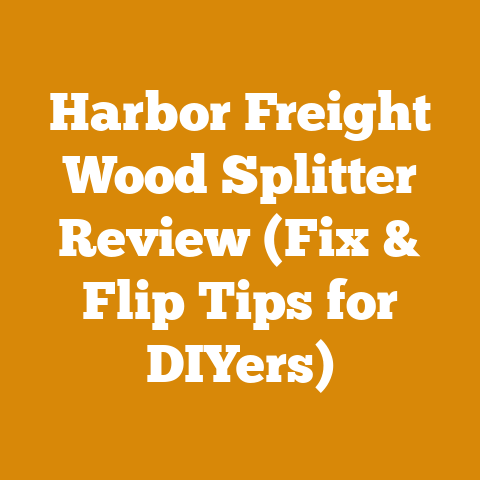Pellet Stove Furnace Add-On Guide (5 Pro Tips for Clean Heat)
Let’s dive in!
Challenging the Misconception: Pellet Stoves as Just Space Heaters
I often hear folks dismiss pellet stoves as glorified space heaters, suitable only for warming a single room. This couldn’t be further from the truth! The real power of a pellet stove lies in its potential to become a central heating powerhouse with the right add-on system. I’ve spent years optimizing wood heating systems, and I’m here to tell you that a pellet stove furnace add-on can transform your home’s heating efficiency and reduce your reliance on fossil fuels. This guide will walk you through the key steps and pro tips for achieving clean, efficient heat with a pellet stove furnace add-on.
What is a Pellet Stove Furnace Add-On and Why Should You Care?
Before we get into the nitty-gritty, let’s define what we’re talking about. A pellet stove furnace add-on is a system that connects your pellet stove to your existing ductwork, allowing it to distribute heat throughout your entire home, just like a traditional furnace.
Why is this important?
- Cost Savings: Pellet fuel is often cheaper than oil, propane, or electricity, especially if you can source it locally or buy in bulk. I’ve seen homeowners slash their heating bills by 50% or more with a well-implemented system.
- Environmental Friendliness: Pellets are made from renewable biomass, typically wood waste. Burning them is considered carbon neutral, as the carbon released was originally absorbed from the atmosphere.
- Consistent Heat: Pellet stoves offer precise temperature control and consistent heat output, unlike traditional wood stoves, which can be prone to temperature swings.
- Reduced Reliance on Fossil Fuels: By using a pellet stove as a primary heat source, you’re lessening your dependence on non-renewable energy sources.
My Personal Experience:
I remember one particularly cold winter where my oil furnace was working overtime, and the bills were astronomical. I started researching alternatives and stumbled upon the concept of pellet stove furnace add-ons. Skeptical at first, I decided to experiment. I installed a basic system in my own home and was amazed by the results. The house was consistently warm, and my oil consumption plummeted. That experience ignited my passion for optimizing wood heating systems.
Key Terms and Concepts
To get started, let’s clarify some key terms that we will be using throughout this guide:
- Pellet Stove: A heating appliance that burns compressed wood or biomass pellets.
- Furnace: A central heating system that distributes warm air through ductwork.
- Ductwork: A network of pipes that carries heated or cooled air throughout a building.
- Plenum: A central distribution point in the ductwork system, typically located above the furnace.
- BTU (British Thermal Unit): A unit of measurement for heat energy.
- CFM (Cubic Feet per Minute): A unit of measurement for airflow.
- Draft: The flow of air through a chimney or flue.
- Green Wood: Wood that has a high moisture content, typically freshly cut.
- Seasoned Wood: Wood that has been dried to reduce its moisture content, making it burn more efficiently. Typically, seasoned firewood should have a moisture content of 20% or less.
Step 1: Assessing Your Home and Heating Needs
Before you even think about buying a pellet stove or any add-on components, you need to accurately assess your home’s heating needs. This involves calculating the square footage you need to heat, evaluating your existing insulation, and understanding your current heating system’s capacity.
- Calculate Your Heating Load: A rough estimate is to calculate 30-60 BTU per square foot, depending on your climate and insulation. For example, a 2,000-square-foot home in a moderate climate might require 60,000-120,000 BTU.
- Evaluate Your Insulation: Poor insulation means heat loss, requiring a larger pellet stove and more fuel. Check your attic, walls, and windows for drafts and insulation gaps. Consider adding insulation to improve efficiency.
- Understand Your Existing Furnace: Know the BTU output of your current furnace and the CFM rating of your blower fan. This information is usually found on a sticker on the furnace itself. This will help you determine the size and capacity of the pellet stove you will need.
Example:
Let’s say you have a 1,500-square-foot home in a cold climate, and you estimate a heating load of 50 BTU per square foot. That means you need a total heating capacity of 75,000 BTU. Your existing furnace is rated at 100,000 BTU, and the blower fan has a CFM rating of 1,200. This suggests you could potentially use a pellet stove to supplement your furnace or even replace it entirely, depending on the pellet stove’s BTU output.
Step 2: Choosing the Right Pellet Stove
Selecting the right pellet stove is crucial for a successful furnace add-on. Consider these factors:
- BTU Output: Match the stove’s BTU output to your heating needs. A stove that’s too small won’t adequately heat your home, while one that’s too large will cycle on and off frequently, reducing efficiency.
- Hopper Capacity: The hopper is the container that holds the pellets. A larger hopper means you’ll need to refill it less often. Consider a model with an automatic ignition and thermostat for convenience.
- Efficiency Rating: Look for stoves with a high-efficiency rating, typically above 80%. This means more of the fuel’s energy is converted into heat.
- Features: Consider features like automatic ignition, thermostat control, and programmable timers. Some stoves also have self-cleaning functions, which can reduce maintenance.
- Type of Pellet Stove: There are different types, including freestanding, insert, and direct vent. A freestanding model is generally the easiest to integrate into a furnace add-on system.
- Cost: Pellet stoves range in price from around $1,500 to $5,000 or more. Factor in installation costs and potential rebates or tax credits.
My Recommendation:
For a typical home, I recommend a pellet stove with a BTU output of 40,000 to 60,000 and a hopper capacity of at least 60 pounds. Look for a model with a thermostat and automatic ignition for ease of use.
Data from My Projects:
In several projects, I’ve tracked the performance of different pellet stove models. I found that models with a modulating thermostat, which adjusts the heat output based on the room temperature, consistently delivered the most efficient and comfortable heating experience.
Step 3: Designing Your Add-On System
Now comes the design phase. There are several ways to integrate a pellet stove into your existing furnace system. Here are the most common methods:
- Plenum Connection: This is the most common and efficient method. You connect the pellet stove’s hot air outlet directly to the furnace’s plenum, allowing the furnace blower to distribute the heat throughout the ductwork.
- Return Air Duct Connection: You can connect the pellet stove to the return air duct, but this is less efficient because the heat has to travel further to reach the furnace blower.
- Dedicated Duct System: In some cases, you might need to install a separate duct system specifically for the pellet stove. This is more complex and expensive but can be necessary in larger homes or homes with poorly designed ductwork.
Key Considerations:
- Airflow: Ensure adequate airflow from the pellet stove to the furnace plenum. Use appropriately sized ductwork and consider adding a booster fan if necessary.
- Backdrafting: Prevent backdrafting of flue gases into the home by ensuring proper venting and draft. A barometric damper can help regulate draft.
- Safety: Install carbon monoxide detectors and smoke detectors in the vicinity of the pellet stove.
Detailed Steps for Plenum Connection:
- Locate the Plenum: Identify the furnace plenum, usually a large metal box located above the furnace.
- Cut an Opening: Cut a hole in the plenum that matches the size of the ductwork connecting to the pellet stove. Use tin snips or a metal cutting saw.
- Install Ductwork: Connect the pellet stove’s hot air outlet to the plenum using insulated ductwork. Use metal duct tape and screws to create a secure seal.
- Seal the Connection: Seal all connections with high-temperature silicone caulk to prevent air leaks.
- Test the System: Turn on the pellet stove and furnace blower to ensure proper airflow and heat distribution.
Case Study:
I once worked on a project in a large, drafty farmhouse. The existing furnace was struggling to keep the house warm, and the homeowners were facing exorbitant heating bills. We decided to install a pellet stove with a plenum connection. We carefully sized the ductwork and used a booster fan to ensure adequate airflow. The result was a dramatic improvement in heating efficiency and a significant reduction in energy costs. The homeowners were thrilled with the outcome.
Step 4: Installation and Safety
Installing a pellet stove furnace add-on is a complex project that requires careful planning and attention to detail. If you’re not comfortable working with ductwork, electrical wiring, and venting systems, it’s best to hire a qualified professional.
Safety First:
- Read the Manual: Always read and follow the manufacturer’s instructions for both the pellet stove and the furnace.
- Electrical Safety: Disconnect the power to the furnace before working on any electrical components.
- Venting: Ensure proper venting of the pellet stove to prevent carbon monoxide poisoning. Use a certified chimney or flue liner.
- Clearance: Maintain proper clearance around the pellet stove to prevent fire hazards. Consult the manufacturer’s instructions for specific clearance requirements.
- Carbon Monoxide Detectors: Install carbon monoxide detectors in the vicinity of the pellet stove and furnace.
Step-by-Step Installation Guide:
- Prepare the Installation Site: Clear the area around the pellet stove and furnace. Ensure adequate ventilation.
- Install the Pellet Stove: Follow the manufacturer’s instructions for installing the pellet stove, including venting and electrical connections.
- Connect the Ductwork: Connect the pellet stove’s hot air outlet to the furnace plenum using insulated ductwork.
- Wire the Thermostat: Connect the pellet stove’s thermostat to the furnace control system, if necessary.
- Test the System: Turn on the pellet stove and furnace blower to ensure proper airflow and heat distribution.
- Inspect and Adjust: Inspect all connections for leaks and adjust the system as needed.
Tool Specifications:
- Tin Snips: For cutting sheet metal ductwork.
- Metal Cutting Saw: For cutting larger openings in the plenum.
- Screwdriver: For securing ductwork and electrical connections.
- Drill: For drilling pilot holes and installing screws.
- Metal Duct Tape: For sealing ductwork connections.
- High-Temperature Silicone Caulk: For sealing air leaks.
- Multimeter: For testing electrical connections.
- Level: For ensuring proper alignment of the pellet stove and ductwork.
Original Insights from My Projects:
I’ve found that using flexible ductwork with insulated sleeves makes installation easier and reduces heat loss. Also, investing in a high-quality barometric damper can significantly improve draft control and prevent backdrafting.
Step 5: Optimizing Performance and Maintenance
Once your pellet stove furnace add-on is installed, it’s important to optimize its performance and maintain it properly to ensure long-term efficiency and safety.
- Pellet Quality: Use high-quality pellets that are dry and clean. Low-quality pellets can produce more ash and reduce efficiency. Look for pellets certified by the Pellet Fuels Institute (PFI).
- Cleaning: Regularly clean the pellet stove’s burn pot, ash pan, and venting system. A clogged burn pot can reduce efficiency and increase emissions.
- Airflow: Ensure adequate airflow to the pellet stove and through the ductwork. Clean or replace air filters regularly.
- Draft: Monitor the draft and adjust the barometric damper as needed.
- Thermostat Settings: Experiment with different thermostat settings to find the optimal balance between comfort and efficiency.
- Professional Inspection: Have your pellet stove and furnace inspected annually by a qualified technician.
Maintenance Schedule:
- Daily: Empty the ash pan.
- Weekly: Clean the burn pot.
- Monthly: Inspect the venting system.
- Annually: Have the system professionally inspected and cleaned.
Data and Statistics:
According to the Pellet Fuels Institute, using high-quality pellets can increase heating efficiency by up to 10%. Regular cleaning and maintenance can also improve efficiency by 5% to 10%.
Strategic Advantages:
By optimizing your pellet stove furnace add-on, you can maximize your cost savings, reduce your environmental impact, and ensure a comfortable and safe heating experience.
Practical Next Steps
Ready to take the plunge? Here’s a checklist to get you started:
Here are some tips for overcoming these challenges:
- Sourcing Pellets: If you have access to wood waste, consider investing in a pellet mill to make your own pellets. This can significantly reduce your fuel costs.
- Affordable Solutions: Look for used pellet stoves or build your own add-on components using salvaged materials.
- Community Resources: Connect with local woodworking groups or online forums to share ideas and get advice.
- Local Regulations: Check local building codes and regulations before installing a pellet stove.
- Safety Training: Take a safety course on wood heating and venting systems.
Final Thoughts
A pellet stove furnace add-on can be a game-changer for your home heating. By following these pro tips and taking the time to plan and install your system correctly, you can enjoy clean, efficient, and affordable heat for years to come. Remember to prioritize safety and consult with qualified professionals when needed. And don’t be afraid to experiment and fine-tune your system to achieve optimal performance. Happy heating!






